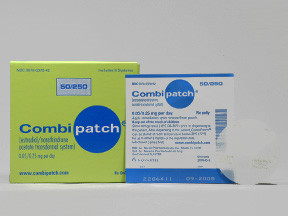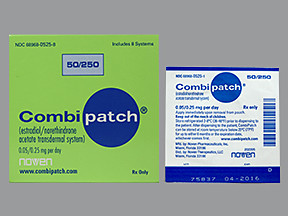ESTRADIOL/NORETHINDRONE ACETATE PATCH - TRANSDERMAL
PHONETIC PRONUNCIATION: (ES-tra-DYE-ol/nor-ETH-in-drone AS-e-tate)
COMMON BRAND NAME(S): Combipatch
GENERIC NAME(S): estradiol/norethindrone acetate
Uses
USES: This medication contains 2 female hormones: an estrogen (estradiol) and a progestin (norethindrone). It is used by women to help reduce symptoms of menopause (such as hot flashes, vaginal dryness). These symptoms are caused by the body making less estrogen. The progestin in this medication helps to reduce the risk of cancer of the uterus which can be caused by using estrogen. Women who have had their uterus removed do not need the progestin and therefore should not use this combination medication. This medication may also be used by women who are not able to produce enough estrogen (for example, due to hypogonadism, primary ovarian failure). If you are using this medication to treat symptoms only in and around the vagina, products applied directly inside the vagina should be considered before medications that are taken by mouth, absorbed through the skin, or injected.
How to use ESTRADIOL/NORETHINDRONE ACETATE PATCH - TRANSDERMAL
HOW TO USE: Read the Patient Information Leaflet if available from your pharmacist before you start using this medication and each time you get a refill. If you have any questions, ask your doctor or pharmacist. Peel off the backing from the patch and apply the patch to a clean, dry area of the lower stomach. Press the patch firmly in place for about 10 seconds to make sure it stays on. Do not apply the patch on the breast or on oily, broken, or irritated skin. Avoid applying the patch to areas of the skin where it might be easily rubbed off (such as the waistline). When wearing the patch, do not expose it to the sun for long periods of time. Use this medication as directed by your doctor. The patch is usually replaced twice a week (every 3 to 4 days). Follow the dosing schedule carefully. The dosage is based on your medical condition and response to treatment. When replacing your patch, make sure to apply the new patch to a different area. Wait at least 1 week before applying a patch to the same area. Fold the old patch in half with the sticky side together and throw away in the trash away from children and pets. Do not flush the patch down the toilet. If a patch falls off, reapply it to a different area. If the patch does not stick completely, then apply a new patch and wear it for the rest of the scheduled period. Do not wear 2 patches at the same time. Use this medication regularly to get the most benefit from it. To help you remember, change the patch on the same days each week. It may help to mark your calendar with a reminder. Tell your doctor if your condition does not improve or if it worsens.
Side Effects
Precautions
Interactions
Overdose
Images

- color
- white
- shape
- round
- imprint
- CombiPatch 0.05/0.25 mg per day

- color
- white
- shape
- round
- imprint
- CombiPatch 0.05/0.25 mg per day

- color
- white
- shape
- round
- imprint
- CombiPatch 0.05/0.14 mg per day
Reviews
Faq for ESTRADIOL/NORETHINDRONE ACETATE PATCH - TRANSDERMAL
Estradiol/norethindrone acetate patch - transdermal is a combination hormone medication used in women to reduce symptoms of menopause, such as hot flashes, vaginal dryness, and night sweats.
The patch releases both estradiol, a form of estrogen, and norethindrone acetate, a form of progestin, through the skin into the bloodstream. These hormones help regulate hormone levels and alleviate menopausal symptoms.
The patch is applied to clean, dry skin on the lower abdomen, upper buttock, or hip. It should be changed twice a week, following the instructions provided with the medication.
Common side effects may include breast pain, headache, nausea, bloating, and mood changes. Serious side effects are rare but may include blood clots, stroke, heart attack, and breast or uterine cancer.
In women with an intact uterus, taking estrogen without progesterone can increase the risk of developing endometrial cancer. Therefore, it is generally recommended to take progesterone alongside estrogen to protect the uterine lining.
No, the patch is not indicated as a method of birth control. It is specifically intended for menopause symptom relief and hormone replacement therapy. You should use alternative contraception methods if you want to prevent pregnancy.
Certain medications, such as rifampin, phenytoin, carbamazepine, and St. John's wort, may decrease the effectiveness of the patch. It’s important to inform your doctor about all the medications and supplements you are taking before starting this treatment.
Yes, the patch is designed to be worn during activities like swimming, bathing, and exercising. It is water-resistant and should stay in place when properly adhered. However, it's always best to follow the specific instructions provided with the patch.
It may take a few weeks for the patch to provide noticeable relief from menopausal symptoms. However, every individual is unique, and some may experience improvements sooner or later than others.
Warning
WARNING: Estrogens, either used alone or with a progestin, have rarely caused very serious side effects. Discuss the risks and benefits of hormone treatment with your doctor. Estrogens and progestins should not be used to prevent heart disease or dementia. In postmenopausal women, estrogen when used with a progestin can increase the risk of heart disease (such as heart attacks), stroke, serious blood clots in the lungs/legs, dementia, and cancer of the breast/ovaries. The risk for serious side effects may depend on the dose of estrogen and the length of time it is used. Therefore, this medication should be used at the lowest effective dose and for the shortest amount of time. Discuss the use of this medication with your doctor regularly (for example, every 3 to 6 months) to see if you still need to use it. If you will be using this medication long-term, you should have regular complete physical exams (for example, once a year) as directed by your doctor. See also Notes section.
Disclaimer
IMPORTANT: HOW TO USE THIS INFORMATION: This is a summary and does NOT have all possible information about this product. This information does not assure that this product is safe, effective, or appropriate for you. This information is not individual medical advice and does not substitute for the advice of your health care professional. Always ask your health care professional for complete information about this product and your specific health needs.


No Reviews Yet